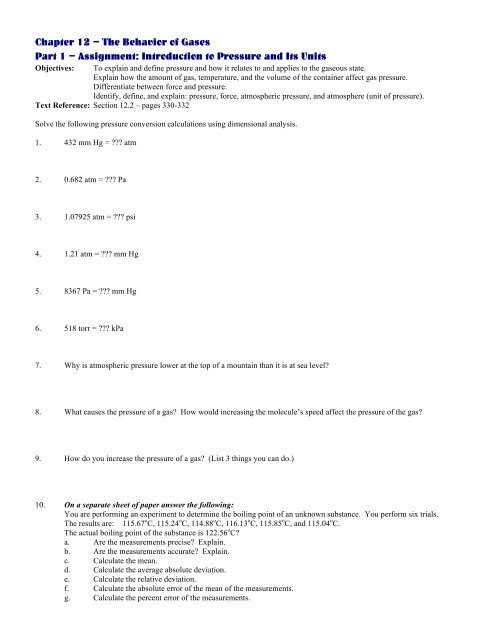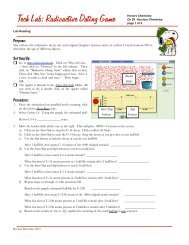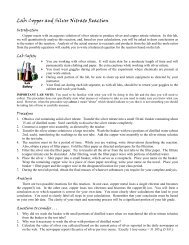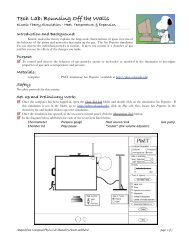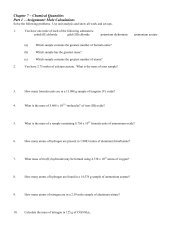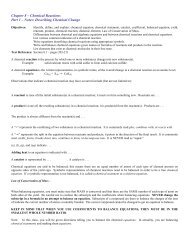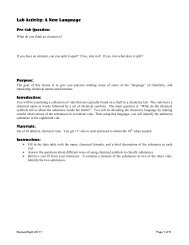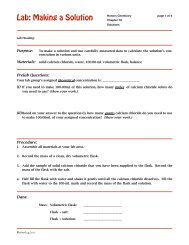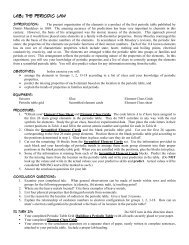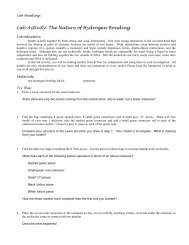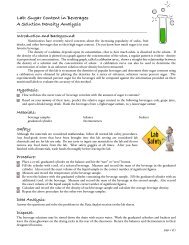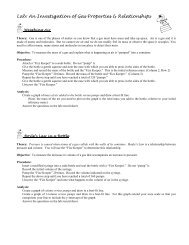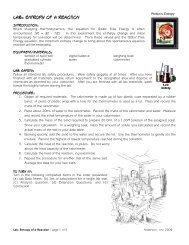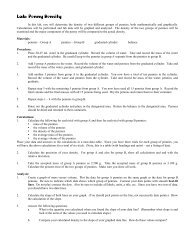Chapter 12 ASSIGNMENTS - Honors Chemistry Coursework
Chapter 12 ASSIGNMENTS - Honors Chemistry Coursework
Chapter 12 ASSIGNMENTS - Honors Chemistry Coursework
You also want an ePaper? Increase the reach of your titles
YUMPU automatically turns print PDFs into web optimized ePapers that Google loves.
<strong>Chapter</strong> <strong>12</strong> – The Behavior of Gases<br />
Part 1 – Assignment: Introduction to Pressure and Its Units<br />
Objectives: To explain and define pressure and how it relates to and applies to the gaseous state.<br />
Explain how the amount of gas, temperature, and the volume of the container affect gas pressure.<br />
Differentiate between force and pressure.<br />
Identify, define, and explain: pressure, force, atmospheric pressure, and atmosphere (unit of pressure).<br />
Text Reference: Section <strong>12</strong>.2 – pages 330-332<br />
Solve the following pressure conversion calculations using dimensional analysis.<br />
1. 432 mm Hg = ??? atm<br />
2. 0.682 atm = ??? Pa<br />
3. 1.07925 atm = ??? psi<br />
4. 1.21 atm = ??? mm Hg<br />
5. 8367 Pa = ??? mm Hg<br />
6. 518 torr = ??? kPa<br />
7. Why is atmospheric pressure lower at the top of a mountain than it is at sea level?<br />
8. What causes the pressure of a gas? How would increasing the molecule’s speed affect the pressure of the gas?<br />
9. How do you increase the pressure of a gas? (List 3 things you can do.)<br />
10. On a separate sheet of paper answer the following:<br />
You are performing an experiment to determine the boiling point of an unknown substance. You perform six trials.<br />
The results are: 115.67 o C, 115.24 o C, 114.88 o C, 116.13 o C, 115.85 o C, and 115.04 o C.<br />
The actual boiling point of the substance is <strong>12</strong>2.56 o C?<br />
a. Are the measurements precise? Explain.<br />
b. Are the measurements accurate? Explain.<br />
c. Calculate the mean.<br />
d. Calculate the average absolute deviation.<br />
e. Calculate the relative deviation.<br />
f. Calculate the absolute error of the mean of the measurements.<br />
g. Calculate the percent error of the measurements.
<strong>Chapter</strong> <strong>12</strong> – The Behavior of Gases<br />
Part 2 – Assignment: The ABCs of Gases – Avogadro. Boyle, & Charles<br />
Solve the following problems and answer the questions. Show all set-ups, units, formulas, etc. BE NEAT!!!<br />
1. A sample of gas in a 25.0-L container exerts a pressure of 3.20 atm. Calculate the pressure exerted by the gas if the<br />
volume is changed to 45.0-L at a constant temperature.<br />
2. A sample of gas in a 21.5-L container at 45 o C is cooled at constant pressure to a temperature of –37 o C at constant<br />
pressure. Determine the volume of the cooled gas.<br />
3. A 32.8 g sample of hydrogen gas occupies a volume of 21.6 L at a particular temperature and pressure. What volume<br />
does <strong>12</strong>.3 g of hydrogen gas occupy at the same pressure and temperature?<br />
4. For Charles’ Law to hold true, why must the pressure and amount of gas remain the same?<br />
5. One of the most obvious properties of gaseous materials is the pressure they exert on their surroundings. In particular, the<br />
pressure exerted by the atmospheric gases is important. How does the pressure of the atmosphere arise, and how is this<br />
pressure commonly measured?<br />
6. What temperature scale is defined with its lowest point as the absolute zero of temperature? What is absolute zero in<br />
Celsius degrees?<br />
7. You are holding two balloons of the same volume. One contains helium and one contains hydrogen. Complete each of<br />
the following statements with “different” or “the same” and justify your answer.<br />
a. The pressures of the gas in the two balloons are ____________________.<br />
b. The temperatures of the gas n the two balloons are ____________________.<br />
c. The numbers of moles of gas in the two balloons are ____________________.<br />
d. The densities of the gas in the two balloons are ____________________.<br />
8. A balloon whose volume is 5.00 L contains 0.275 mole nitrogen. What mass, in grams, must be present to have a volume<br />
of 11.0 L at the same temperature and pressure conditions?<br />
9. A gas has a volume of 426 mL at 118 o C. What is the temperature of the gas if the volume increases to 636 mL?<br />
10. The volume of a gas is changed from 475 mL to 195 mL. The initial pressure was 775 mmHg, if the quantity and<br />
temperature remain the same, what is the final pressure?
<strong>Chapter</strong> <strong>12</strong> – The Behavior of Gases<br />
Part 3 – Assignment: Ideal Gas Law and Combined Gas Law<br />
Solve the following problems and answer the questions. Show all set-ups, units, formulas, etc. BE NEAT!!!<br />
1. What would happen to the pressure of a sample of Cl 2 if the volume and the absolute temperature were both tripled?<br />
2. What would happen to the volume of a sample of N 2 if the pressure is doubled and the absolute temperature is tripled?<br />
3. A gas has a volume of 1635 mL at 792 Torr and –32 o C. What is the volume of the gas at STP?<br />
4. What volume will 1.87 mol of an ideal gas occupy at 397 K and 134.6 kPa of pressure?<br />
5. How many molecules of carbon dioxide are present in a 2850 mL sample at STP?<br />
6. A spherical space colony proposed by Gerald O’Neill (Princeton University) has a diameter of 1.00km. How many grams of<br />
nitrogen are needed to fill the interior of the colony at 1.00atm and 20. o C if the nitrogen is 78.5% of the entire atmosphere?<br />
7. A 2.00L container is placed in a constant temperature bath and is filled with 3.05g of CH 3 CH 3 . The pressure stabilizes at 800.<br />
Torr. What is the temperature of this constant temperature water bath?<br />
8. If 28.0 g of a gas occupy 22.4 L at STP, what would the gas be?<br />
A. CO B. CO 2 C. C 2 H 2 D. C 2 H 6
9. The mass of 11.2 L of a gas is 20.0 g at STP. What is the mass of 6.02x10 23 molecules of this gas?<br />
A. 10.0 g B. 20.0 g C. 40.0 g D. 80.0 g<br />
10. At STP, 5.6 L of CH 4 contains the same number of molecules as:<br />
A. 1.4 L oxygen B. 2.8 L ammonia C. 5.6 L hydrogen D. 11.2 L neon<br />
11. Are the following statements true or false? Show work to prove your answer choice.<br />
According to the Ideal Gas Law . . .<br />
(a) density increases with pressure.<br />
(b)<br />
molar mass increases with temperature.<br />
(c)<br />
for a fixed amount of gas, the quantity PV/T is constant.<br />
(d) when T and n are kept constant, doubling the volume doubles the pressure.<br />
<strong>Chapter</strong> <strong>12</strong> – The Behavior of Gases<br />
Part 4 – Assignment: Dalton’s Law of Partial Pressure<br />
1. A gaseous mixture contains 20.0 g neon and 14.5 g helium in a 15.0 L container at constant temperature. The partial<br />
pressure of the helium gas is 3.25 atm. What is the total pressure of the system?<br />
2. Calculate the number of moles in a 4.00 L sample of a gas at 300. K containing oxygen at 0.650 atm and nitrogen at 0.220<br />
atm. Also calculate the number of moles of oxygen and the number of moles of nitrogen present.<br />
3. 14.0 g nitrogen and 14.0 g hydrogen are placed in a container and the total pressure is 3.75 atm. (a) What is the partial<br />
pressure of hydrogen? (b) What is the partial pressure of the nitrogen?
4. A sample containing 0.80 mol oxygen gas is collected over water at 30.0 o C. The total pressure is 1.10 atm and the water<br />
vapor pressure at 30.0 o C is 31.8 torr. Determine the volume of the oxygen gas.<br />
5. A gas collected over water at 20. o C and at 780. mm Hg has a volume of 42.65 mL. What is the volume of the “dry”gas at<br />
STP? The vapor pressure of water at 20. o C is 17 mm Hg.<br />
6. A student is preparing for a laboratory experiment in which three gases will be mixed together. There is a 2-L sample of<br />
neon gas at a pressure of 2 atm, a 2-L sample of carbon dioxide gas at a pressure of 3 atm, and a 2-L sample of nitrogen<br />
gas at a pressure of 4 atm. All three samples are at room temperature. In the experiment the three gases will be<br />
transferred to the same rigid 2-L container.<br />
(A) What pressure should the student expect the nitrogen gas to exert in the final mixture?<br />
a. 2 atm b. 3 atm c. 4 atm d. 9 atm<br />
(B)<br />
What total pressure should the student expect the gases to exert in the final mixture?<br />
a. 4 atm b. 5 atm c. 9 atm d. <strong>12</strong> atm<br />
7. A 2.00L container holds 4.00 moles of O 2 and 2.70 moles of He at 293K. What is the partial pressure of O 2 ? . . . of He?<br />
What is the total pressure?<br />
8. The density of air at 1.000atm and 25 o C is 1.186 g/L.<br />
(a) Calculate the average molar mass of air.<br />
(b) From this value, and assuming that air contains only molecular nitrogen and molecular oxygen gases, calculate<br />
the mass fraction of nitrogen and oxygen in air.<br />
9. Consider two bulbs connected by a valve. Bulb A has a volume of 200.0mL and contains nitrogen at a pressure of<br />
0.500atm. Bulb B has a volume of 1.00L and contains CO gas at a pressure of 1.00atm. What is the pressure in the two<br />
tanks when the valve is opened? The volume of the connecting tube and valve is negligible. Also, nitrogen does not react<br />
with carbon monoxide.
<strong>Chapter</strong> <strong>12</strong> – The Behavior of Gases<br />
Part 5 – Assignment: Monometers and Graham’s Law<br />
If the atmospheric pressure is 775 mm Hg, what is the pressure of the gas in the manometer vessel in the following diagrams?<br />
1. 2. 3.<br />
8.75 cm 6.32 cm 45.6 mm Hg<br />
Draw the following manometers registering the listed pressures. Atmospheric pressure for these problems is 737 mm Hg.<br />
4. closed; 225 mm Hg 5. open; 560 mm Hg 6. open; 880 mm Hg<br />
7. What is the molar mass of a gas that diffuses 3.00 times faster than SO 2 ?<br />
8. What is the molar mass of a gas that diffuses exactly one-half as fast as carbon dioxide?<br />
9. You have equal amounts of two gases at the same temperature and pressure: neon and fluorine. Which diffuses faster?<br />
How much faster?<br />
10. An unknown gas diffuses 2.75 times faster than sulfur trioxide. What is the molar mass of the unknown gas?<br />
11. Consider a sealed tank kept at a constant temperature. The tank contains 8.00mol He, 2.00mol CH 4 , and 1.00mol O 2 .<br />
(a) Which gas in the tank has the highest partial pressure?<br />
(b)<br />
(c)<br />
(d)<br />
Which gas will effuse out first if a tiny hole if punched into the tank?<br />
Which gas in the tank has the highest mass percent of the mixture?<br />
If 4.00mol He are replaced by 4.00mol SO 2 gas, would the pressure change, and if so, in which direction?<br />
(e)<br />
If 4.00mol He were replaced by 8.00g SO 2 , would the pressure change, and if so, in which direction?
<strong>Chapter</strong> <strong>12</strong> – The Behavior of Gases<br />
Part 6 – Assignment: Kinetic Molecular Theory<br />
Solve the following problems and answer the questions. Show all set-ups, units, formulas, etc. BE NEAT!!!<br />
1. Using the postulates of the kinetic molecular theory, explain how these postulates account for the following properties of<br />
a gas:<br />
a. the pressure of a gas<br />
b. pressure increases with an increase in temperature<br />
c. a gas fills its entire container<br />
d. volume of a gas increases with an increase in temperature<br />
2. You are holding two balloons that have the same volume, an orange balloon and a blue balloon. The orange balloon is<br />
filled with neon gas and the blue balloon is filled with argon gas. Which of the following best represents the mass ratio of<br />
Ne:Ar in the balloons?<br />
A. 1:1 B. 1:2 C. 2:1<br />
3. You have two containers at the same temperature and pressure. Container #1 has 1 mole oxygen gas and Container #2<br />
has 1 mole hydrogen gas. Indicate how these containers compare in . . . (Explain why.)<br />
a. volume.<br />
b. number of molecules in each container.<br />
c. density of sample.<br />
d. average kinetic energy.<br />
4. 5.6 L of oxygen (at STP) are placed in a container along with 1.0 g of hydrogen. The partial pressure of the hydrogen is<br />
1.0 atm. What is the total pressure of the mixture?<br />
5. A mixture of 14.0 g nitrogen and 34.0 g NH 3 is contained in a 2500. mL vessel at 27 o C. (A) Calculate the total pressure.<br />
(B) Calculate the mole fraction of NH 3 . (C) Calculate the partial pressure of the nitrogen.
6. At 300.K, gas tank A and gas tank B each contain two moles of gas. Tank A contains nitrogen gas, while tank B contains<br />
oxygen gas.<br />
(a) Compare the kinetic energy of the molecules in tanks A and B.<br />
(b) Compare the velocity of the molecules in tanks A and B.<br />
(c) Compare the time it takes for the molecules to effuse out of tanks A and B.<br />
7. Are the following statements true or false? Show your work or provide a brief explanation to justify your answer.<br />
A gas at 25 o C in a 10.0L sealed stainless steel tank has a pressure of 1.00atm. When the temperature in the tank is<br />
doubled to 50 o C . . .<br />
(a) the volume of the tank doubles.<br />
(b)<br />
the pressure in the tank doubles.<br />
(c)<br />
the number of moles of gas doubles.<br />
(d)<br />
the kinetic energy of the molecules increases.<br />
(e)<br />
the velocity of the molecules stays the same.<br />
<strong>Chapter</strong> <strong>12</strong> – The Behavior of Gases<br />
Part 7 – Assignment: Gas Laws and Stoichiometry<br />
Solve the following problems using unit analysis where appropriate. Show all units, set-ups, equations, etc.<br />
1. At a deep-sea station 200. m below the surface of the Pacific Ocean, workers live in a highly pressurized environment.<br />
How many liters of gas, at STP, must be taken from the surface and compressed to fill the underwater environment with<br />
7.00x10 7 L of a gas at 20.0 atm? Assume a constant temperature.<br />
2. How many liters of hydrogen gas may be produced at 27 o C and 104 kPa, if 20.00 g sodium metal are reacted with water?
3. Magnesium will burn in the presence of oxygen to form magnesium oxide. What mass of magnesium will react with<br />
500.0 mL of oxygen at STP?<br />
4. What volume of ammonia gas (NH 3 ) at 85 o C and 2.85 atm can be produced by the reaction of 4.50 g hydrogen gas with<br />
excess nitrogen gas?<br />
5. When 3.00 moles of hydrogen gas react with 2.00 moles of nitrogen gas, ammonia gas (NH 3 ) is formed.<br />
a. Write a balanced chemical equation.<br />
b. Calculate the volume of 3.00 moles of hydrogen at STP. Calculate the volume of 2.00 moles nitrogen at STP.<br />
c. Find the limiting reactant.<br />
d. Calculate the liters of gas produced when it is collected at 1.87 atm and <strong>12</strong>5 o C.<br />
e. Calculate the volume of excess left over after the reaction is completed at 1.87 atm and <strong>12</strong>5 o C.<br />
6. 15.0 L of methane gas (CH 4 ) is at 85.0 kPa and 175 o C. What volume of oxygen is required for the combustion of all the<br />
methane if the oxygen is at the same temperature and pressure conditions as the methane?<br />
7. Oxygen gas generated by the decomposition of potassium chlorate is collected over water at 25 o in a 1.00L flask at a total<br />
pressure of 755.3 torr. The vapor pressure of water at 25 o C is 23.8 torr. How many moles of KClO 3 were consumed in<br />
the reaction?


